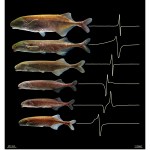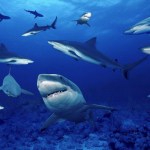fish
Check out this video of an archer fish (Toxotes jaculatrix) shooting down prey by creating a water jet:
Here it is again in slow motion:
Until now, the mechanism by which the archer fish produces such a powerful jet of water was a mystery. Contrary to prior hypotheses, the fish do not have specialized internal structures. Dr. Alberto Vailati and colleagues at the University of Milan filmed the fish and found that the initial jet of water travels at an impressive 2 meters per second and the lagging end of the water jet is actually faster. The end result: the head of the water jet is held…
Magnetite in a fish nasal cell. Image: The Scientist from Herve Cadiou, University of Cambridge
In a prior blog, we talked about different animals that are able to sense the Earth's magnetic field. The mystery of how fish, and perhaps other animals, do this may be solved. Animals use the magnetic field like a compass. This is an important skill especially to migratory species who don't have the benefit of Google Maps. It is sort of a built-in GPS system.
Dr. Michael Walker from the University of Auckland discovered that brain cells connected to the nasal cavity of fish can be…
The 10 winning images from the inaugural Bio-Art competition hosted by the Federation of American Societies for Experimental Biology (FASEB) were announced last week. Here are my favorites:
Closely related species of electric fish with recordings of their electric organ discharge. This organ is used for communication and prey location, similar to echolocation used by bats. Note how the pattern differs between species. Submitted by Matthew E. Arnegard (Fred Hutchinson Cancer Research Center, Seattle, WA), Derrick J. Zwickl (University of Kansas, Lawrence) as well as Ying Lu…
As a result of our last posting on Fukushima, we had a discussion initiated by commenter Daedelus2u about radioactive istopes of Cesium becoming concentrated in fish. I thought I'd take this opportunity to expand on that discussion a little. This relates to the possibility that radioactive elements spilled or spewed from a nuclear reactor site (as per normal or following a meltdown and China Syndrome, as in the case of Fukushima) can become part of our diet especially in fish, and how much concentration of radioactive isotopes we might expect.
Ana's feed is loaded with startling and…
When analyzing data, understanding the limitations of your data is critical. One of the things we need to understand is significance: how strong does an effect have to be to considered not a result of random chance. Typically, we assume that if an effect has a five percent or less probability of occurring due to random chance, then it is "significant." But significance becomes very problematic when making many simultaneous assessments. If we make one hundred assessments (e.g., comparisons) and not a single one is actually different (assume that the Omniscience of the Mad Biologist is…
This post considering the evolutionary origins of numerical cognition, specifically in terms of the approximation of large numbers, is meant as a companion to this week's series on the developmental origins of numerical cognition and developmental dyscalculia, at Child's Play.
What are the origins of number representation in the mind? Are there any innate building blocks that contribute to our understanding of mathematics and number, or must everything be learned?
Number is an important domain of human knowledge. Many decisions in life are based on quantitative evidence, sometimes with life…
by Elizabeth Grossman
"After three long months of oil geysering continuously from the depths of the Gulf, a temporary cap has stemmed the flow and it appears that the well is on its way to being killed. But we are by no means through this disaster," said Senator Sheldon Whitehouse (D-RI) in his opening remarks at the August 4th Senate Environment and Public Works Committee hearing on the use of oil dispersants in the BP/Deepwater Horizon oil spill.
Gulf Coast fishermen and others whose livelihoods depend on the Gulf of Mexico's sea life know this all too well.
While the scientists testifying…
tags: The Oil Spill's Unseen Culprits, Victims, health, environment, ecology, pollution, oilspill, BP, acidification, Gulf of Mexico, dispersants, Carl Safina, TEDTalks, TED Talks, streaming video
The Gulf oil spill dwarfs comprehension, but we know this much: it's bad. Carl Safina scrapes out the facts in this blood-boiling cross-examination, arguing that the consequences will stretch far beyond the Gulf -- and many so-called solutions are making the situation worse.
TEDTalks is a daily video podcast of the best talks and performances from the TED Conference, where the world's leading…
tags: Close Encounter with a Whale Shark in the Gulf of Mexico, marine biology, field research, research, technology, whale shark, Rhincodon typus, satellite tags, Gulf of Mexico, BP, Gulf Coast Research Laboratory, University of Southern Mississippi, streaming video
Whale Shark, Rhincodon typus, feeding in the Gulf of Mexico.
Image: Gulf Coast Research Laboratory Whale Shark Research.
Despite being the largest fish species in the world, measuring over 40 feet in length and 35 tons in weight, whale sharks are quite mysterious. We know they are plankton filter feeders, and we recently…
tags: Evolution in Action by AMNH, Congo River, fishes, AMNH, American Museum of Natural History, evolution, variation, biodiversity, Melanie Stiassny, streaming video
This video tells the story of speciation in Central Africa's roiling, rapid Lower Congo River. This river is home to an extraordinary assortment of fish -- many truly bizarre. This new video by Science Bulletins, the American Museum of Natural History's current-science video program, features Museum scientists on a quest to understand why so many species have evolved here. Follow Curator of Ichthyology Melanie Stiassny and her…
tags: Inside the Collections: Ichthyology at AMNH, fishes, AMNH, American Museum of Natural History, evolution, variation, biodiversity, Melanie Stiassny, streaming video
This video is the first of a new series of behind-the-scenes looks at the collections at the American Museum of Natural History. In this video, Melanie Stiassny, Axelrod Research Curator in the Department of Ichthyology, takes us through the Museum's vast collection of fishes.
The Department of Ichthyology, one of the four departments within the Museum's Division of Vertebrate Zoology, houses a collection that comprises more…
tags: ecology, marine biology, conservation biology, endangered species, habitat preferences, Northern Bluefin Tuna, Atlantic Bluefin Tuna, Thunnus thynnus, Yellowfin Tuna, Thunnus albacares, fisheries, PLoS ONE, researchblogging.org,peer-reviewed research, journal club
An adult Atlantic (Northern) Bluefin Tuna, Thunnus thynnus.
A recently published study, intended to provide data to commercial fisheries in the Gulf of Mexico so they maximize their catch of Yellowfin Tuna, Thunnus albacares, whilst avoiding bycatch of critically endangered Atlantic (Northern) Bluefin Tuna, Thunnus thynnus…
tags: Care for Some Crude With Your Sushi?, toro sushi, maguro sushi, Atlantic Bluefin Tuna, Thunnus thynnus, Gulf of Mexico, pollution, oil spill, Deepwater Horizon, BP, British Petroleum, overfishing, endangered species, conservation, marine biology, streaming video
The Gulf of Mexico oil spill is the worst environmental disaster the US has faced. Toxic oil from the Deepwater Horizon well threatens the region's sensitive shorelines and the nesting birds along the Louisiana coast. But there's another species at serious risk: the Atlantic bluefin tuna, Thunnus thynnus. This disturbing video…
tags: Brian Skerry Reveals Ocean's Glory -- and Horror, conservation, marine biology, fish, marine mammals, oceans, sharks, leatherback sea turtle, right whale, overfishing, photographer, Brian Skerry, TEDTalks, TED Talks, streaming video
Professional photographer Brian Skerry shoots life above and below the waves -- as he puts it, both the horror and the magic of the ocean. Sharing amazing, intimate shots of undersea creatures, he shows how powerful images can help make change.
TEDTalks is a daily video podcast of the best talks and performances from the TED Conference, where the world's…
The skeleton of Palaeobatrachus from Lake Enspel, Germany. From Wuttke and Poschmann, 2010.
In On the Origin of Species, Charles Darwin said of the fossil record:
For my part, following out Lyell's metaphor, I look at the natural geological record, as a history of the world imperfectly kept, and written in a changing dialect; of this history we possess the last volume alone, relating only to two or three countries. Of this volume, only here and there a short chapter has been preserved; and of each page, only here and there a few lines. Each word of the slowly-changing language, in which…
tags: Bait Ball Feast, natural history, animal behavior, plankton, herring, seabird, humpback whale, television, BBC, streaming video
In late summer, the plankton bloom is at its height. Vast shoals of herring gather to feed on it, diving birds round the fish up into a bait ball.
tags: Octopus versus Fish, Chinaman Leatherjacket, animal behavior, predatory behavior, documentary, Jervis Bay, Australia, streaming video
A scuba diver captured this interesting footage of a group of Chinaman Leatherjacket fish attacking and killing an Octopus, in Jeris Bay, Australia, in this is an amazing display of animal behavior.
tags: How we Wrecked the Ocean, oceans, fish, fishing industry, introduced species, biological pollution, chemical pollution, climate change, coral bleaching, Jeremy Jackson, TEDTalks, TED Talks, streaming video
In this bracing talk, coral reef ecologist Jeremy Jackson lays out the shocking state of the ocean today: overfished, overheated, polluted, with indicators that things will get much worse. Astonishing photos and stats make the case. So in a nutshell: we've wrecked everything around us: the water, the air, the animals, the climate, and any illusion of world peace we ever had. We're…
One of the fossil fish I found in the Green River Formation of Wyoming.
I had my doubts about whether we were going to reach the quarry. The Toyota Yaris my wife and I had rented for our excursion through Utah and Wyoming was not designed to handle the rough dirt roads which wound their way through the grassy hills of the Equality State, but eventually the outcrop of grey-and-yellow rocks came into view. It was part of the famous Green River Formation, an approximately 42-53 million year old slice of earth's history known to be rich in fish fossils.
It did not take long to start finding…
tags: Life in the Aphotic Zone, animals, marine life, marine biology, bioluminescence, benthic zone, abyssal zone, streaming video
This fascinating video captures a glimpse of the weird and wonderful animals that live in the aphotic zone. The aphotic zone (aphotic from Greek prefix á¼- + Ïá¿¶Ï "without light") is the portion of a lake or ocean where there is little or no sunlight. It is formally defined as the depths beyond which less than 1% of sunlight penetrates. Consequently, bioluminescence is essentially the only light found in this zone. Most food comes from dead organisms sinking to…



